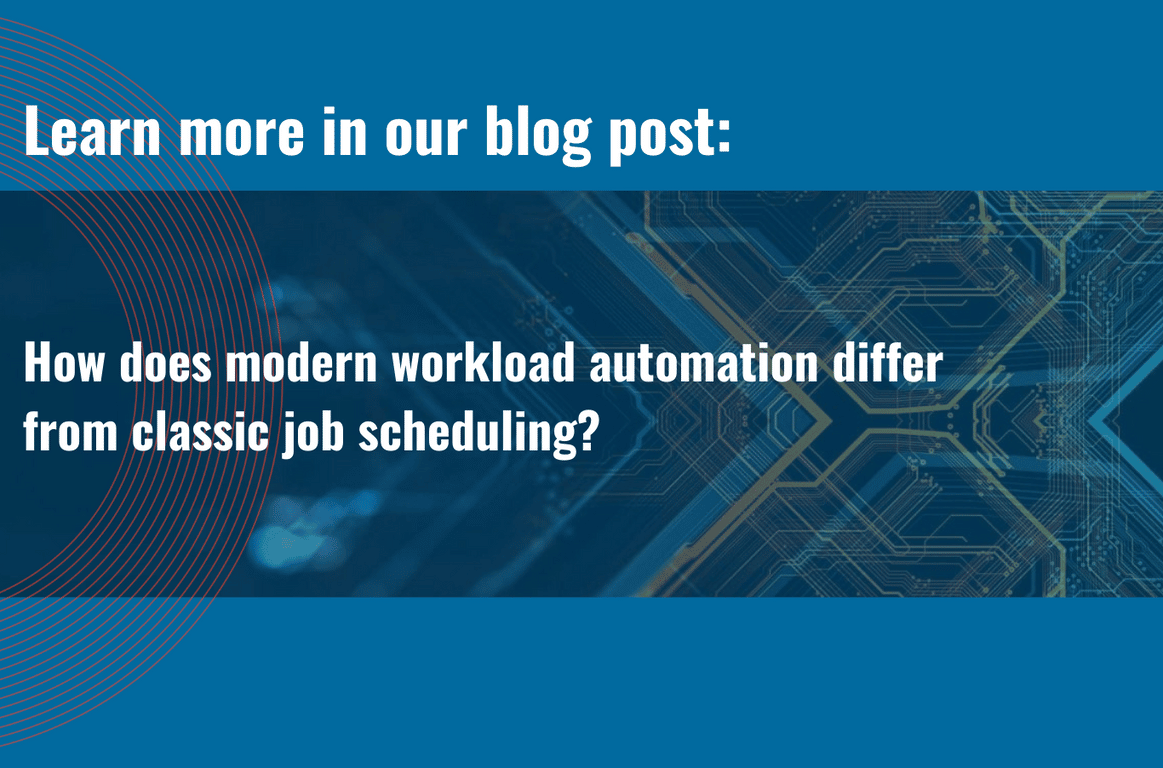Modern Workload Automation (WLA) and Robotic Process Automation (RPA) are both forms of automation technology, but they differ in their focus and capabilities.
WLA focuses on automating repetitive IT operations, such as scheduling, monitoring and managing batch jobs, across an organization’s IT infrastructure.
RPA, on the other hand, focuses on automating repetitive, manual, and rules-based tasks performed by humans, such as data entry or customer service inquiries, using software robots or virtual agents.
So which solutions is better for your modern IT? Let’s take a deeper look:
What is Workload Automation?
Workload Automation is a type of software that automates the scheduling, execution, and monitoring of repetitive IT operations and tasks. WLA is used to manage and orchestrate various IT operations such as batch processing, data transfers, system updates, and database maintenance.
By automating these operations, WLA helps organizations to improve efficiency, reduce manual errors, and increase reliability. WLA can also help organizations to manage the increasing complexity of their IT environments by providing a unified and automated approach to managing IT operations.
WLA can be used in a variety of IT environments, including on-premise, cloud, and hybrid environments, and can support a range of operating systems, databases, and middleware.
Isn’t workload automation obsolete as opposed to RPA?
Nope, it is not. WLA remains a critical component of modern IT operations, as it helps organizations automate repetitive and time-consuming IT tasks, such as scheduling and executing batch jobs, data transfers, and system updates.
In recent years, WLA has evolved to include new capabilities, such as cloud and container orchestration, and the integration with other technologies such as Robotic Process Automation and Artificial Intelligence (AI). These advancements have made WLA more powerful and relevant than ever.
In summary, while the technology and capabilities of WLA have evolved, its core purpose of automating IT operations remains essential to modern IT environments.
What is RPA?
Robotic Process Automation is a technology that enables organizations to automate repetitive, manual, and rules-based tasks performed by humans using software robots or virtual agents.RPA technology uses algorithms and artificial intelligence to mimic the actions of a human worker, such as data entry, form filling, and customer service inquiries. The software robots can interact with various systems and applications, including web-based and desktop applications, to perform the tasks.
By automating routine tasks, RPA helps organizations to improve efficiency, reduce errors, and free up employees to focus on higher-value tasks. Additionally, RPA can improve the overall customer experience by providing faster and more accurate service.
RPA is often used in a variety of industries, including financial services, healthcare, retail, and government, and can be integrated with other forms of automation and technologies, such as Workload Automation and Artificial Intelligence.
how can both WLA and RPA work together in modern IT?
Modern IT environments can leverage the complementary strengths of both Workload Automation and Robotic Process Automation to streamline operations and improve efficiency.
WLA can be used to manage and orchestrate RPA bots, automating the deployment and execution of RPA processes as part of a larger IT workflow.
RPA bots, on the other hand, can trigger and interact with other automated IT processes managed by WLA, such as data transfers or system updates.
By integrating WLA and RPA, organizations can achieve a more comprehensive automation strategy that can span both back-end IT operations and front-end business processes, resulting in improved efficiency and cost savings.
WLA solutions are designed to coordinate and manage various tools, processes, and workflows from a single program window, allowing IT to orchestrate workflows across the enterprise. Some WLA solutions also offer pre-built, out-of-the-box job steps for building end-to-end workflows without custom scripts, making it easier to integrate diverse technologies and develop an automation framework for the organization.
Additionally, some WLA solutions offer self-service automation portals for business professionals, which provide a simplified interface for running workloads, while IT still retains control and ownership.
Whether to use WLA or RPA comes down to an organization’s automation strategy. If the IT team is using the right Low-Code WLA solution, they can automate many tasks without needing an RPA solution. WLA can automate what would otherwise need multiple RPA tools to manage, monitor, and coordinate. WLA tools also integrate programmatically, reducing the risk of common RPA failures.
The decision on whether to use WLA or RPA ultimately depends on how IT views automation: as a crucial part of their strategy or a secondary consideration.

